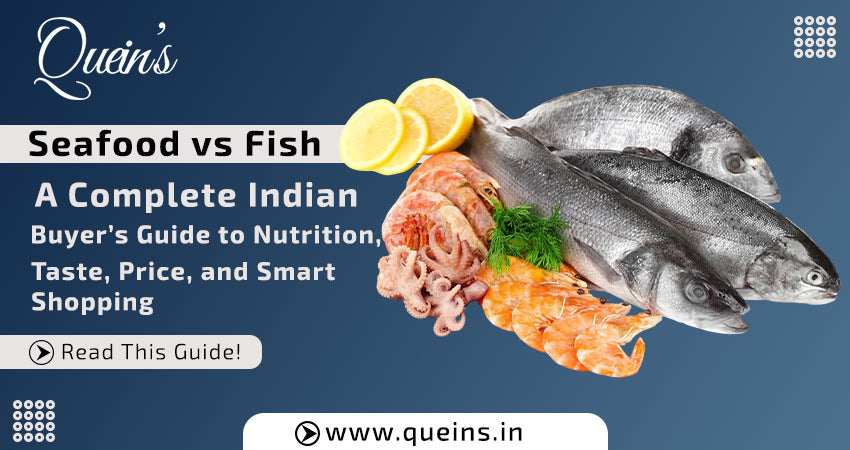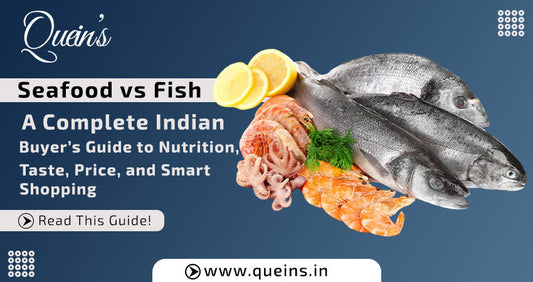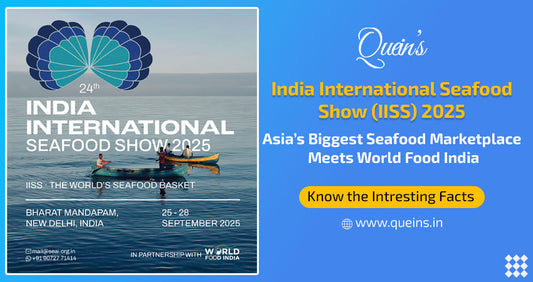
Confused about seafood vs fish? This quick guide from Quein’s explains the key differences, nutrition (incl. omega-rich fish), pricing, cooking times, and how to choose truly fresh fish or seafood online—so you buy smarter and cook better.
1) Seafood vs Fish — Clear Definitions You Can Trust
Many shoppers use “seafood” and “fish” as if they’re the same. They aren’t, and the difference matters when you cook, compare nutrition, or plan a budget.
- Fish: Aquatic vertebrates with a backbone. In India, common food fish include Rohu, Catla, Pomfret, Surmai/Seer, Mackerel (Bangda), Sardines (Tarli/Mathi), Hilsa, Indian Salmon (Raavas).
- Seafood: An umbrella term covering fish and non-fish aquatic foods such as prawns/shrimp, crabs, lobsters (crustaceans) and oysters, clams, mussels, squid, cuttlefish (mollusks/cephalopods).
Why this distinction helps:
- Allergies: Fish allergy is different from shellfish allergy. Knowing which you’re serving keeps guests safe.
- Nutrition: Omega rich fish (like mackerel or sardines) differ nutritionally from, say, prawns or squid.
- Prices & Prep: Some expensive seafood (lobster, jumbo prawns) behaves and is priced very differently from everyday fish.
- Sustainability: Fishing methods vs crustacean farming have different environmental footprints.
2) Why “Seafood vs Fish” Confuses People (And Why It Shouldn’t)
Language habits, restaurant menus, and market boards often lump everything under “seafood.” That’s okay informally, but for shoppers it hides useful detail.
- Buying clarity: If you say “seafood,” a seller may offer prawns; if you wanted fish steaks, you’ll be disappointed.
- Cooking success: Prawns overcook in minutes; fish steaks are more forgiving. Clear terms help you nail doneness.
- Diet planning: If your doctor recommends fish for health, they usually mean fish with higher EPA/DHA omega-3—not necessarily shellfish.
3) Nutrition 101 — Where Fish and Other Seafood Shine (and Differ)
Both fish and shellfish are excellent proteins, but their strengths aren’t identical.
3.1 Protein Quality and Satiety
- Fish: Delivers complete, high-quality protein that supports muscle repair and steady energy. Great for weight-management plans.
- Shellfish (prawns, crab, mussels): Also high-quality, typically lean and low in saturated fat—useful for high-protein, lower-calorie meals.
3.2 Omega-3 Fats (EPA/DHA)
- Oily fish (mackerel, sardines, salmon, certain seasonal fish) are naturally rich in EPA & DHA, linked to heart, brain, and eye health.
- Shellfish do contain omega-3 but generally less than oily fish. They compensate with unique minerals (see below).
3.3 Vitamins & Minerals
- Fish: Often a reliable source of vitamin B12, vitamin D (especially in fatty fish), iodine, selenium, and phosphorus. Small fish eaten whole (sardines) add calcium from bones.
- Shellfish: Oysters, clams, mussels can be rich in zinc, iron, and copper—useful for immunity and energy metabolism.
3.4 Cholesterol & Real-World Health
- Prawns and squid can show higher dietary cholesterol, but they’re low in saturated fat. For most people, overall diet quality matters more than cholesterol in a single item. Pair shellfish with whole grains/veg and modest fat for balance.
Takeaway: For omega-3 focus, fish—particularly omega rich fish—usually win. For lean, mineral-rich options, shellfish are fantastic. Rotate both.
4) Omega Rich Fish — What They Are and How to Use Them
Omega-3s (EPA/DHA) are the headline nutrients when people compare seafood vs fish for health.
- Affordable daily heroes: Mackerel (Bangda) and Sardines (Tarli/Mathi)—widely available, boldly flavoured, excellent grilled or curried.
- Popular steaks: Surmai/Seer fish—meaty, versatile; not as oily as sardines/mackerel but easy for beginners.
- Regional classics: Hilsa (Ilish)—rich and seasonal; prized for flavor in the East.
- Indian “Salmon” (Raavas): Availability/identity varies by region; still a preferred “special” choice.
How often? Many nutrition frameworks suggest fish 2–3 times per week, with at least one oily fish meal—adjust as advised by your healthcare professional.
5) Taste, Texture & Cooking Science — Why Timing Matters
Fish and shellfish don’t behave the same in the pan.
5.1 White Fish vs Oily Fish
- White fish (Pomfret, Tilapia, Basa): Mild taste, delicate flakes. Great for steam, shallow fry, or light curries.
- Oily fish (Mackerel, Sardines): Fuller flavour, firmer texture, stand up to strong spices, mustard, vinegar, or smoking.
5.2 Shellfish Nuances
- Prawns/Shrimp: Cook fast; turn pink and opaque. Overcook and they go rubbery. Aim for just-done.
- Squid/Cuttlefish: Two sweet spots—either very quick (1–2 minutes) or low and slow (30+ minutes). The in-between zone toughens them.
- Crab/Lobster: Sweet, delicate meat. Moisture is key—steam/boil till just done, or simmer in spice-rich masalas.
5.3 Practical Chef Tips
- Pat dry before searing: Surface moisture prevents browning.
- Salt timing: Salt fish 10–15 minutes before cooking for better seasoning; rinse/dab if needed for delicate species.
- Carryover heat: Remove from flame just before perfect; residual heat finishes doneness.
- Acid wisely: Lemon/vinegar brighten oily fish; add toward the end to avoid turning the texture mushy.
6) Price 101 — Why Some Seafood Is Expensive (and How to Shop Smart)
“Expensive seafood” isn’t a mystery—it reflects economics and logistics.
- Scarcity & Demand: Lobster, jumbo crab, large prawns cost more than common fish due to limited availability and high demand.
- Seasonality & Fuel: Monsoon and fuel prices push costs; expect fluctuations in the Fish & Seafood Market.
- Cold-Chain Complexity: Imported salmon or premium shellfish require meticulous cold storage—this adds to price.
- Yield After Cleaning: Shell-on prawns and crab have lower edible yield; you pay for shell and labor.
- Sustainability Premium: Eco-friendly fishing, certifications, and ethical labor increase costs—many buyers are willing to pay for this.
Budget strategy: Prefer local, seasonal food fish (mackerel, sardines, rohu, catla) and medium-sized prawns for balance of price, taste, and nutrition.
7) Fresh vs Frozen — What Indian Buyers Must Know
“Fresh” isn’t just about time; it’s about handling.
- Truly fresh fish should have bright eyes, firm flesh, tight scales, red gills, and a clean ocean/river smell (not sour or ammonia).
- IQF (Individually Quick Frozen) locks quality soon after catch. Properly processed frozen can be better than poorly handled “fresh.”
- Glazing & Net Weight: Responsible sellers declare glazing percentage (ice coating) and net weight after thawing.
- Thawing right: Thaw in the fridge (never on the counter), pat dry, and cook promptly.
Quein’s promise: Clear cut types, cold-chain integrity, and transparent weight/cleaning details so you get what you pay for.
8) Safety, Allergies & Mercury — Family-First Choices
- Allergy clarity: Fish and shellfish are different allergens. If you’re unsure, introduce new items in small amounts and consult a professional for known sensitivities.
- Mercury awareness: Prefer small to medium species (sardine, mackerel) more often; limit very large predatory fish.
- Parasites & hygiene: Buy from reliable sellers, cook to safe doneness, and avoid cross-contamination between raw and cooked surfaces.
- Pregnancy & kids: Many healthcare providers allow low-mercury fish as part of a balanced diet; follow personalized medical advice.
9) Buying Online in India — A Step-by-Step Checklist
Shopping online can be safer and cleaner when you use a trusted store.
- Define the dish: Curry, grill, steam, or fry? This decides species and cut.
- Choose the cut: Steaks for grills/curries; fillets for pan/steam; whole for roasting or steaming.
- Read the specs: Size (prawn count per kg), net weight after cleaning, skin-on vs skinless, bone-in vs boneless.
- Cleaning options: Ask for de-veined prawns, deboned fillets to save time.
- Delivery slot: Pick a window when you can immediately refrigerate or cook.
- Storage plan: Batch-cook or portion and freeze if buying weekly.
- Seller transparency: Look for date labels, handling notes, and honest reviews.
At Quein’s, we display cut, cleaning, size, and usage suggestions, making selection painless.
10) Regional India — Popular Picks and Why People Love Them
India’s coastline and rivers create a vibrant Fish & Seafood Market with strong regional tastes.
- West Coast (Maharashtra, Goa, Karnataka): Surmai/Seer, Pomfret, Mackerel, Prawns, Crab. Bold spices, kokum, coconut.
- South (Kerala, TN, AP, Telangana): Seer, Pearl spot (Karimeen), Anchovies, Squid. Coconut milk curries, pepper roasts, appam pairings.
- East (Bengal, Odisha): Hilsa, Rohu, Catla, Prawns/Chingri. Mustard gravies, delicate steaming.
- North & Central (Delhi-NCR, MP): Rohu, Catla, Basa/Tilapia, prawns via cold-chain. Restaurant-style grills and makhani gravies.
- Gujarat: Pomfret, Surmai, Rohu, Prawns. Clean flavours, lime, green chilli, coriander.
Why this matters: Regional familiarity helps you cook with confidence and buy in-season, which keeps costs reasonable and flavours high.
11) Easy, Healthy Plates — Balanced Meals You’ll Actually Cook
Goal: Keep prep short, nutrition high, and flavours satisfying.
-
Omega Fry Plate (15 min): Pan-seared mackerel + lemon millet + cucumber raita.
- Why it works: Omega-3 rich fish for heart health; grain + yogurt balance macros.
-
Prawn Coconut Express (20 min): Medium prawns in coconut milk, curry leaves, mustard seeds; serve with red rice.
- Why it works: Lean protein; coconut fat + spices = big flavour with quick cooking.
-
Tawa Pomfret + Kachumber (20 min): Chilli-turmeric marinade, shallow fry; fresh salad on the side.
- Why it works: Crisp outside, moist inside; salad cuts richness.
-
Crab Pepper Roast (30–35 min): Cracked crab with black pepper-garlic; serve with appam/soft rotis.
- Why it works: Weekend “treat” from the expensive seafood basket—pepper enhances sweetness.
-
Sardine Tomato Stew (25 min): Sardines simmered with tomato, onion, ginger-garlic; serve with steamed rice.
- Why it works: Budget-friendly omega rich fish plus pantry staples.
12) Market Trends — What Smart Indian Shoppers Notice
- Traceability & cold-chain: More buyers prefer stores that disclose sourcing and maintain chill integrity.
- Ready-to-cook cuts: Clean fillets, de-veined prawns, and spice-rub steaks fit urban schedules.
- Local first, import for occasions: Everyday meals lean on regional fish; imports reserved for special menus.
- Sustainability signals: Line-caught tags, seasonal catch, and community fisheries attract conscious buyers.
Quein’s approach: Clarity on cut/size/origin, hygienic processing, and options from everyday fish to expensive seafood for celebrations.
13) Myths Busted — Quick, Honest Explanations
-
Myth: Seafood always means fish.
Fact: Seafood includes fish + shellfish (prawns, crab, squid, oysters, etc.). -
Myth: Frozen = poor quality.
Fact: Proper IQF can be superb—sometimes fresher than badly handled “fresh.” -
Myth: All seafood is expensive.
Fact: Mackerel, sardines, rohu are nutrient-dense and affordable. -
Myth: Prawns are “bad” due to cholesterol.
Fact: Prawns are lean; keep portions sensible within a balanced diet. -
Myth: Only imported fish are omega-rich.
Fact: Indian mackerel and sardines are classic omega rich fish.
14) FAQs — Detailed Answers You’ll Actually Use
Q1. Seafood vs fish — what’s the practical difference when cooking?
A: Fish steaks/fillets are forgiving; shellfish cook very fast. For prawns and squid, seconds matter—overcook and they toughen. Plan timing accordingly.
Q2. What’s the best fish for health if I’m watching my heart?
A: Include oily fish like mackerel or sardines 1–2 times weekly. Rotate with white fish and shellfish for variety and micronutrients.
Q3. Is seafood generally pricier than fish?
A: Not always. Shellfish like lobster and jumbo prawns can be pricey; local seasonal fish remain affordable. Choose based on season and size for value.
Q4. Fresh vs frozen — which should I buy?
A: Buy from a seller with cold-chain discipline. Properly handled fresh or IQF can be excellent. Quality depends on processing, not just the label.
Q5. How do I avoid a fishy smell at home?
A: Buy fresh, keep cold, pat dry before cooking, and ventilate the kitchen. Citrus, vinegar, ginger-garlic, and fresh herbs help neutralize odours.
Q6. How do I pick prawns online?
A: Check count per kg, whether they’re de-veined, and net weight after cleaning. Medium sizes are versatile and budget-friendly.
Q7. Any sustainability tips for families?
A: Rotate species, prefer small-to-medium fish, and support sellers who share sourcing details and seasonal advice.
15) Final Verdict — So, Which Wins: Seafood or Fish?
There’s no single champion in seafood vs fish—they serve different goals.
- Choose fish (especially omega rich fish) for heart-friendly EPA/DHA and classic Indian curries or grills.
- Choose shellfish when you want lean protein, fast cooking, and mineral diversity (zinc, iron).
- Best strategy: Rotate oily fish, white fish, and shellfish through the week to cover nutrition, taste, and budget—exactly how Indian home kitchens already thrive.
16) Why Buy from Quein’s — Your Online Fish & Seafood Partner
Quein’s – Fish & Seafood Online Store in India simplifies every step:
- Wide Range: Everyday food fish to premium expensive seafood for special days.
- Omega Labels: Easy picks for fish for health—look for omega rich fish tags.
- Exact Cuts & Cleaning: Fillets, steaks, whole; de-veined prawns; ready-to-cook options.
- Transparent Specs: Size, count/kg, net weight after cleaning, and cooking suggestions.
- Cold-Chain & Hygiene: Strict handling for real freshness.
- Convenient Delivery: Time slots that match your kitchen routine, plus honest customer support.
Shop smarter, cook happier. With Quein’s, “seafood vs fish” becomes a weekly rotation you’ll love—balanced, flavourful, and always fresh.



